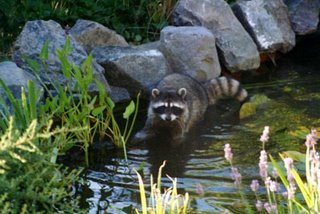Algae can easily be controlled.
1. Balance your vegetation, marginals (with good root systems such as
Pickerel, Iris), oxygenators (parrots feather, anacharis) and surface
coverage (water lilies, parrot’s feather). Also be patient, nature tends to
correct itself. I've found that patience is much better than trying to
overcontrol pond chemistry.
2. When pH gets on the basic side algae flourishes. Vinegar is weak and it takes forever (days) to neutralize. But it takes an expert to use muriatic acid properly, so do not put concentrated muriatic acid in your pond to balance pH!
3. It is good to have algae slime on the sides of your pond... this is a
sign of a healthy pond and can generate up to 70% of the oxygen needed for
your pond.
4. If you feed your fish, use a biological filter. The nitrate load will always get high.
5. Fresh water mussels work great and multiply faster than goldfish. But
if you get hungry they are great over linguini.
6. Scotch Barley bales work, but the pond must be cleared of algae first and
it will take some time to initiate the decomposition process. Approximately
3 months in a zone 6 winter or 1 month during the summer, i.e. you will need
overlap when exchanging the bales.
7. Black dye is very effective and is asetheticaly pleasing to show off
water lilies, but again the pond must be cleared first of algae. The other
trick is having the right amount in the pond. Since I use a white sand/pea
gravel for my pot topping, I add dye until I do not see the stones. This is
tricky, because it can slow plant growth if put in too strong and if not put
in high enough concentration you will get algae formation. If you do go down
this road, then stay away from the blue or green dyes. Trust me you will not
like the result.
8. There are several products on the market that will wipe out algae
population without harming fish or desirable plants. The downside is they
wipe out all of the algae and you may end up with an anaerobic pond.
9. Displace 25% of your water with non-chlorinated water (well or rain) on a
weekly basis during > 80 F weather.
10. UV (ozone) will work and is good when you have a lot of fish. The down
side is the ozone is a great oxidant and will kill some of the beneficial
critters. UV lights will NOT work for blanketweek/filamentous algae.







